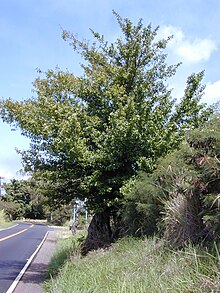Sideroxylon
- "Bully Tree" (and variants thereof) redirect here, but may include the related Broad-leaved Lacuma (Pouteria multiflora). "Sideroxylon" is also an oxymoron introduced by Arthur Schopenhauer, see Wooden iron, and is occasionally used for petrified wood; it is also a 1983 album by The Celibate Rifles.
| Sideroxylon | |
|---|---|

| |
| Sideroxylon persimile | |
| Scientific classification | |
| Kingdom: | |
| (unranked): | |
| (unranked): | |
| (unranked): | |
| Order: | |
| Family: | |
| Genus: | Sideroxylon |
| Species | |
|
About 70, see text | |
| Synonyms | |
|
Bumelia Sw. | |
Sideroxylon is a genus of flowering plants in the family Sapotaceae. There are about 70 species, collectively known as bully trees. The genus is distributed mainly in the neotropics, but also in Africa, Madagascar, and the Mascarene Islands. Some species, such as Gum Bully (S. lanuginosum), S. tenax, and Buckthorn Bully (S. lycioides), are found in subtropical areas of North America. The only South African species, the White Milkwood (S. inerme), is associated with three historical sites, and these individuals were declared national monuments due to their unusual longevity.
Several species have become rare due to logging and other forms of habitat destruction. The Tambalacoque of Mauritius (S. grandiflorum, syn. Calvaria major) was affected by the extinction of the birds which dispersed its seed; it was suggested that the species entirely depended on the dodo for that purpose and nearly became a victim of coextinction, but this is not correct.[1][2] Bully trees provide food for the caterpillars of certain Lepidoptera, such as the Bumelia Webworm Moth (Urodus parvula).
Selected species

Formerly placed here
- Miracle fruit, Synsepalum dulcificum (as Sideroxylon dulcificum)
- Spiniluma discolor (as Sideroxylon discolor)
- Dipholis salicifolia (as Sideroxylon salicifolium(L.) Lam) – White Bully, Willow Bustic
References
- ^ Witmer, M. C. & Cheke, A. S. (1991): The dodo and the tambalacoque tree: an obligate mutualism reconsidered. Oikos 61(1): 133-137. HTML abstract
- ^ Hershey, D. R. (2004): The widespread misconception that the tambalacoque absolutely required the dodo for its seeds to germinate. Plant Science Bulletin 50: 105-108.
